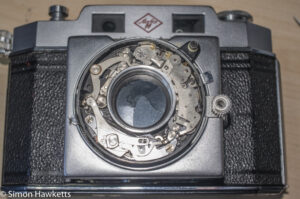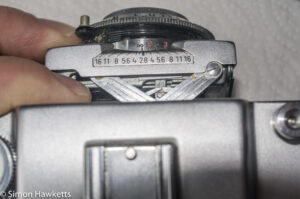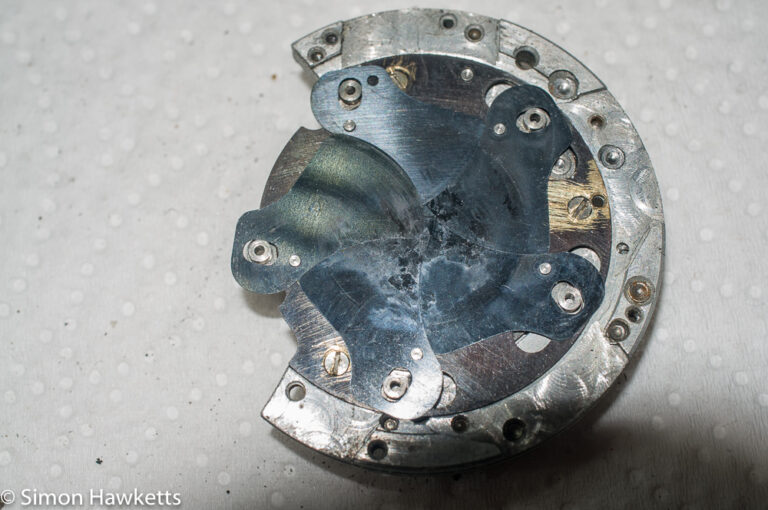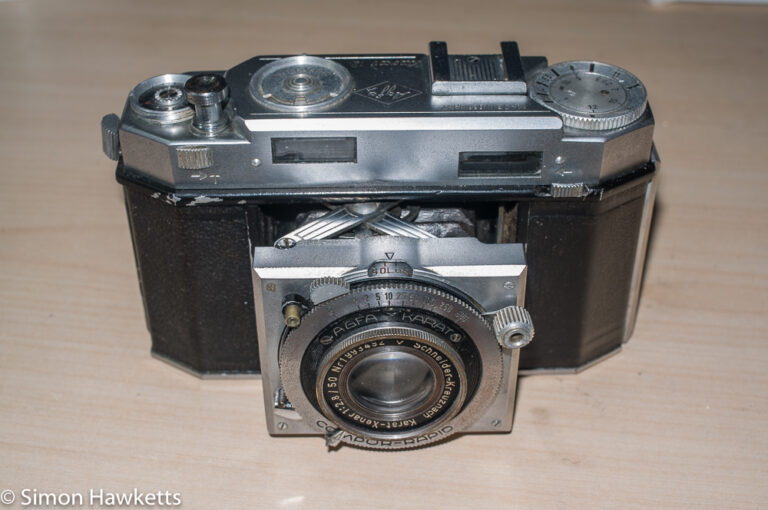Agfa Karat IV repairs and cleanup
Over the last couple of days I’ve been fixing various issues I’ve found with my Agfa Karat IV 35 mm rangefinder camera and this post gives a few details of my Agfa Karat IV repairs. The problems with the camera were that the shutter wouldn’t fire, the film transport was ‘gritty’ and the interlock didn’t always work, and the focus was very stiff to operate.
There are quite a lot of pictures in this post and some of them were taken single handedly as I was carrying out the work so they may not be completely accurately focused and exposed – apologies for that.
Agfa Karat IV Repairs – Shutter
The first issue I had to address was the Prontor SVS shutter, which gave no indication that it was being cocked when the film transport was activated, and didn’t fire when the shutter release was pressed. Initially, I removed the front lens element by unscrewing it and removed the front plate and speed selector ring to reveal the shutter mechanism.
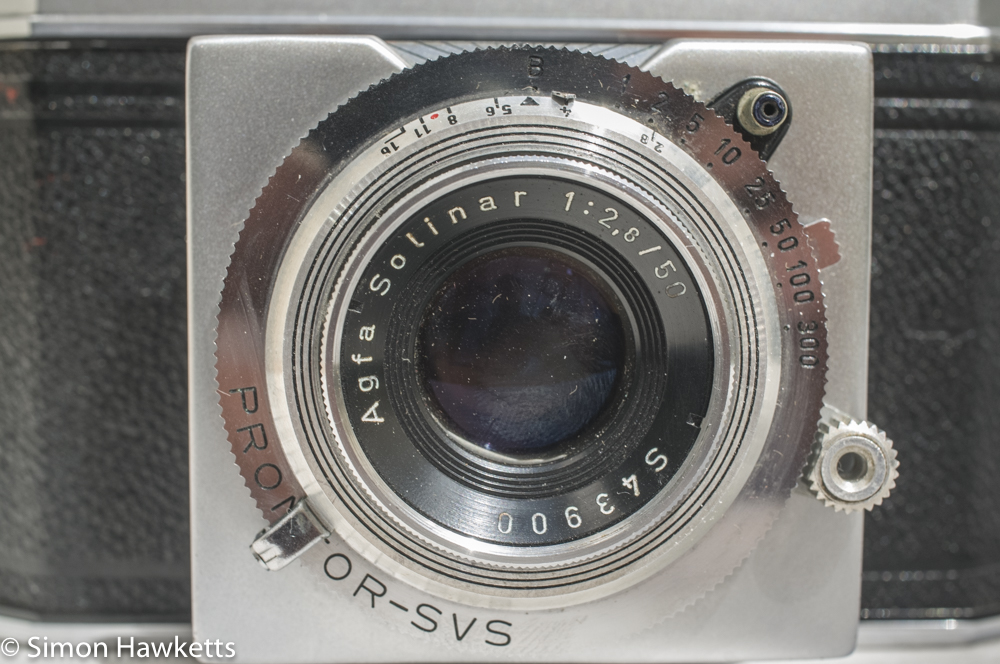
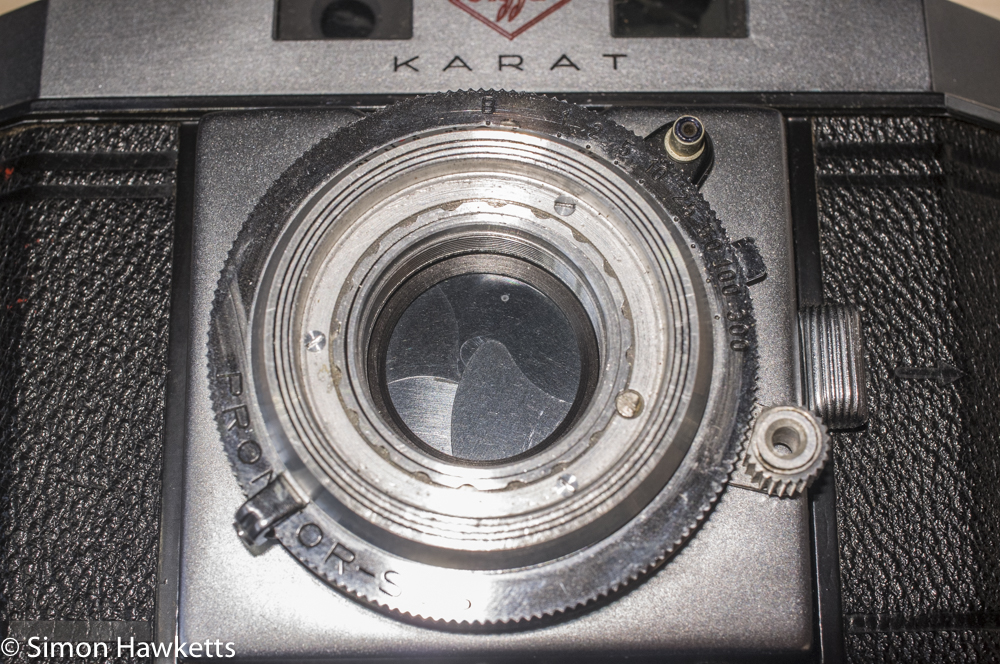


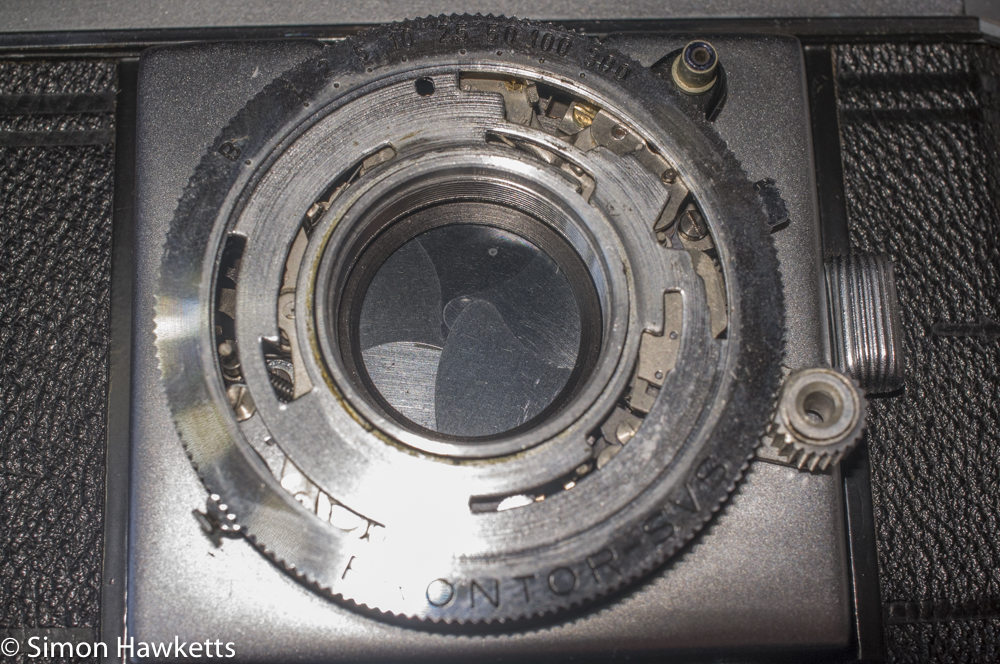
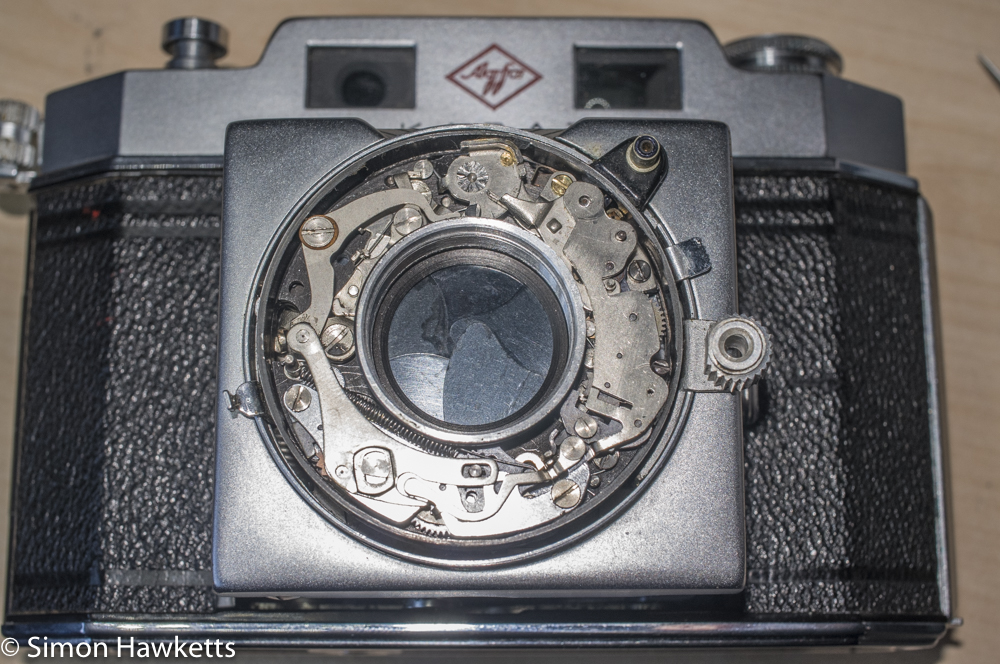
To get access to the shutter, the front element just unscrews by turning it anti-clockwise. It may feel a bit stiff at first, but it does undo. Once it’s off you will see a screw with a flattened side which is used to lock the ring which holds on the aperture display. Turn this screw until the ring can be turned, and then unscrew the ring anti-clockwise. Again, it may be difficult to move initially, and you may need to push it with something to get it going. Be careful what you use because the materials used here are quite soft and will be scratched with, for example, a screwdriver.
Once the ring is off, the aperture scale component will be free, but you need to undo the screw which holds it to the actual aperture control arm on the shutter, then it will lift off. The speed selector plate is then just pressed onto the shutter and can be lifted off.
When I had the shutter exposed, I found that the lens was cocked, but the self-timer was wound up and frozen. Because I wasn’t sure if there were any other problems, I just pushed on the pin of the self-timer to wind it down and then helped the shutter to fire with a set of tweezers.
When it fired, there was another issue because the slow speed escapement was also very reluctant to move, and I also had to help it to complete its travel. Once these two components were in their ‘normal’ positions, I tried moving the film advance and found that the shutter was cocking, but when I pressed the shutter release the shutter wouldn’t fire. Again, I had to help it by pressing down on the shutter release lever with a set of tweezers, and again the slow speed stopped the mechanism.
So I had to fix the slow speed by removing it from the shutter (there are two black screws which you can see when the shutter is cocked) and flushing it with IPA to get rid of all the old muck and grease which was blocking it. Once that was done, the slow speeds were back to their normal timings. I will also need to do the same operation to the self-timer, but I haven’t yet done that.
The other problem was that the shutter release wasn’t travelling far enough to fire the shutter, and to fix that I needed to remove the shutter from the camera to get to the release mechanism. Since I also needed to re-grease the focus helicoid, that was the job I tackled next.
Agfa Karat IV Repairs – Focus re-greasing
A common problem with the Karat series of camera is that the grease used in the focusing helicoid goes solid after the camera has been left for a long time. It’s not uncommon for the focus control to be completely locked.
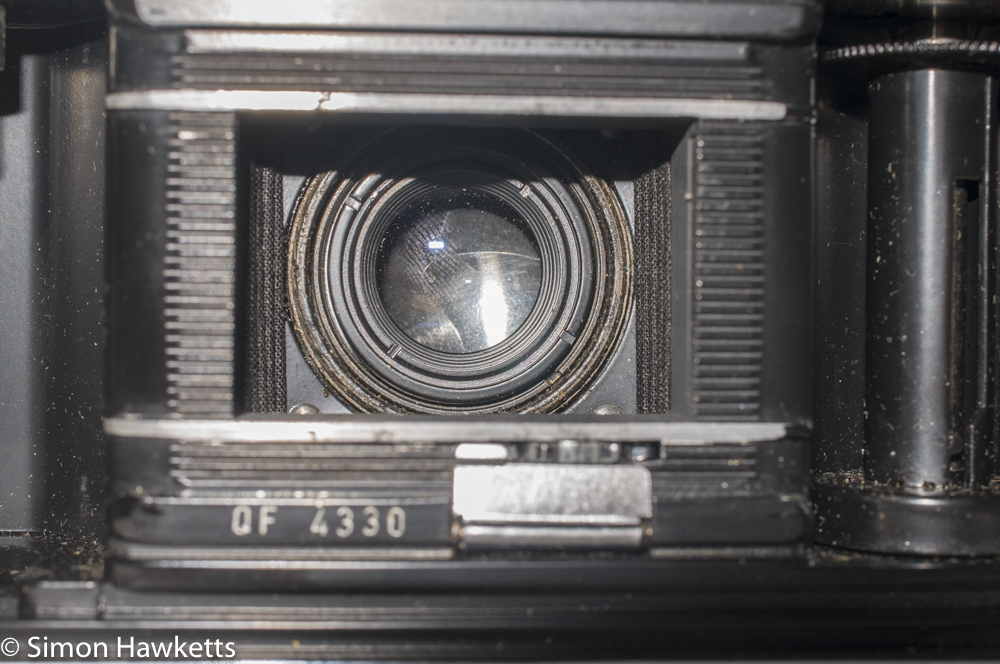


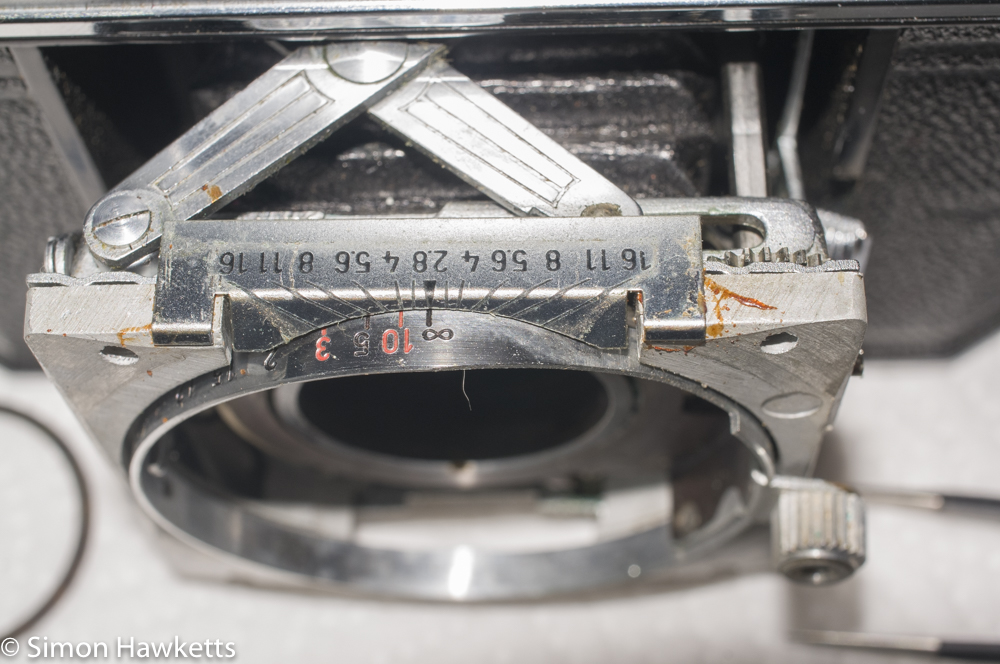
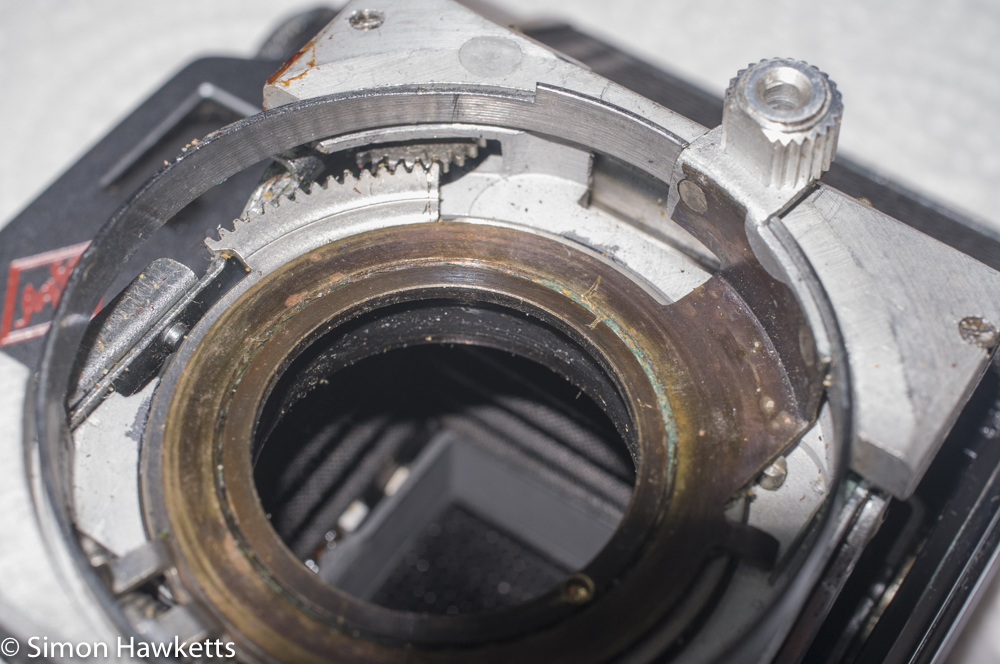
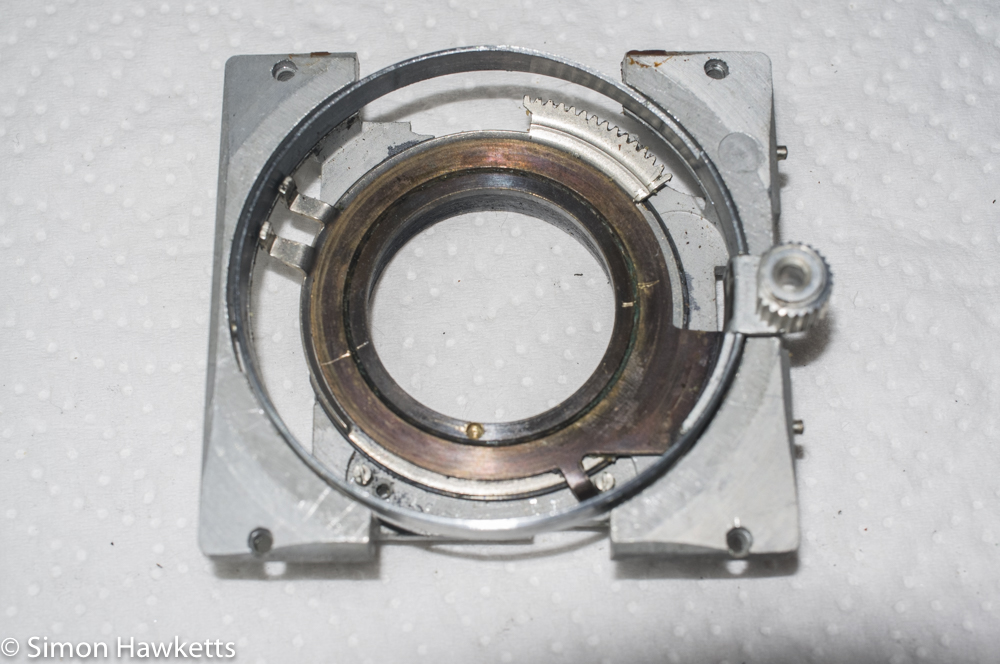
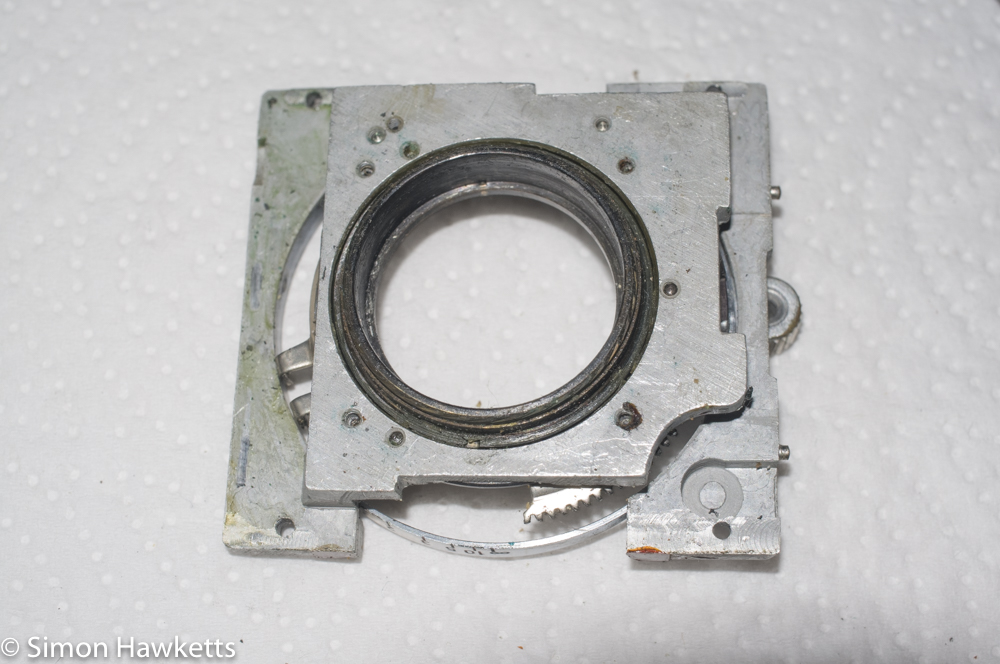
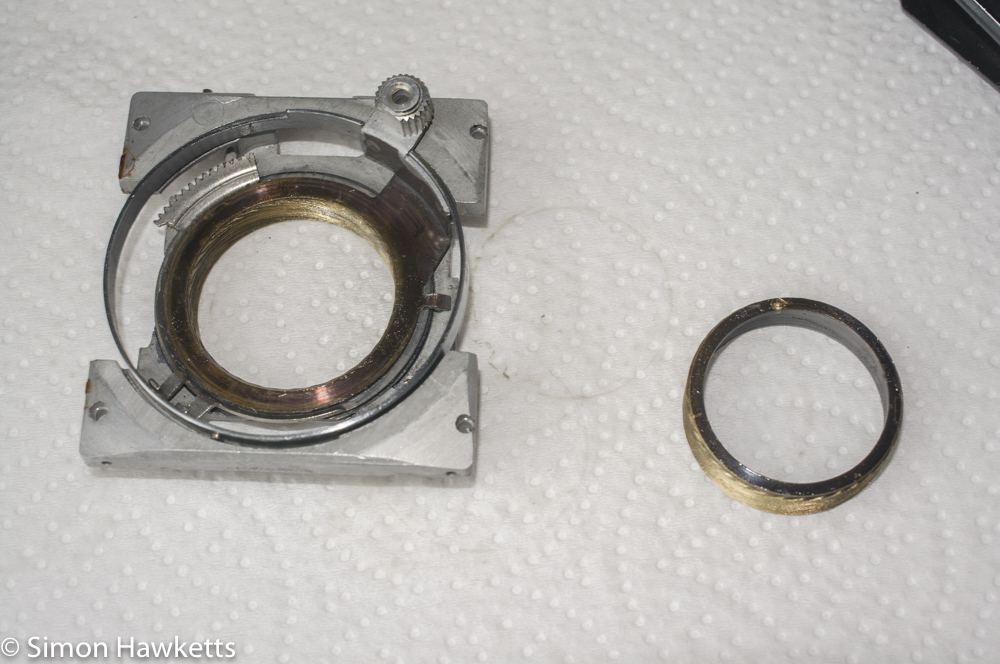
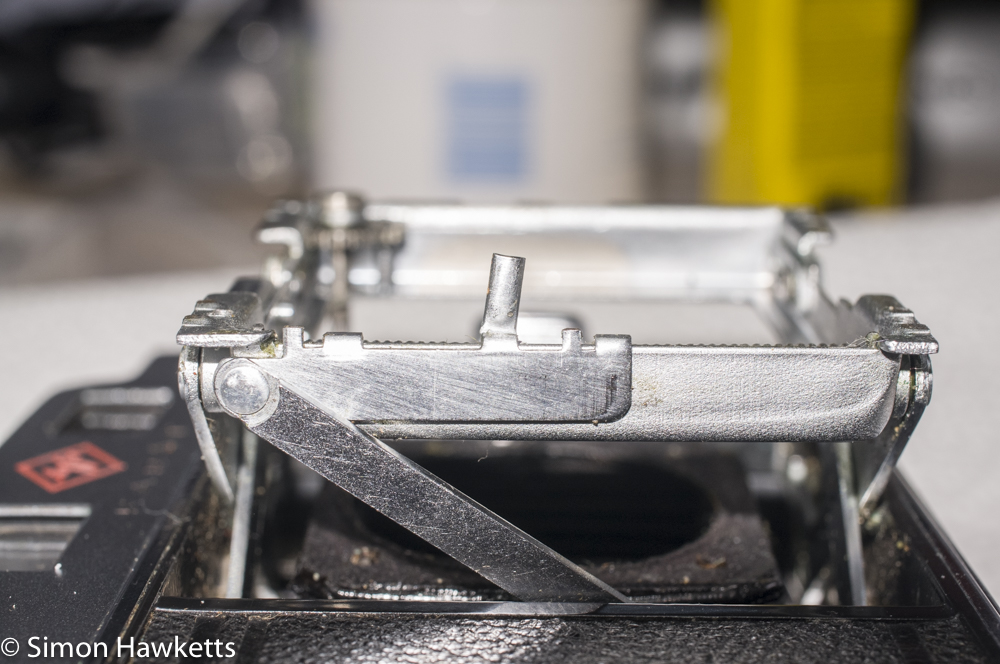
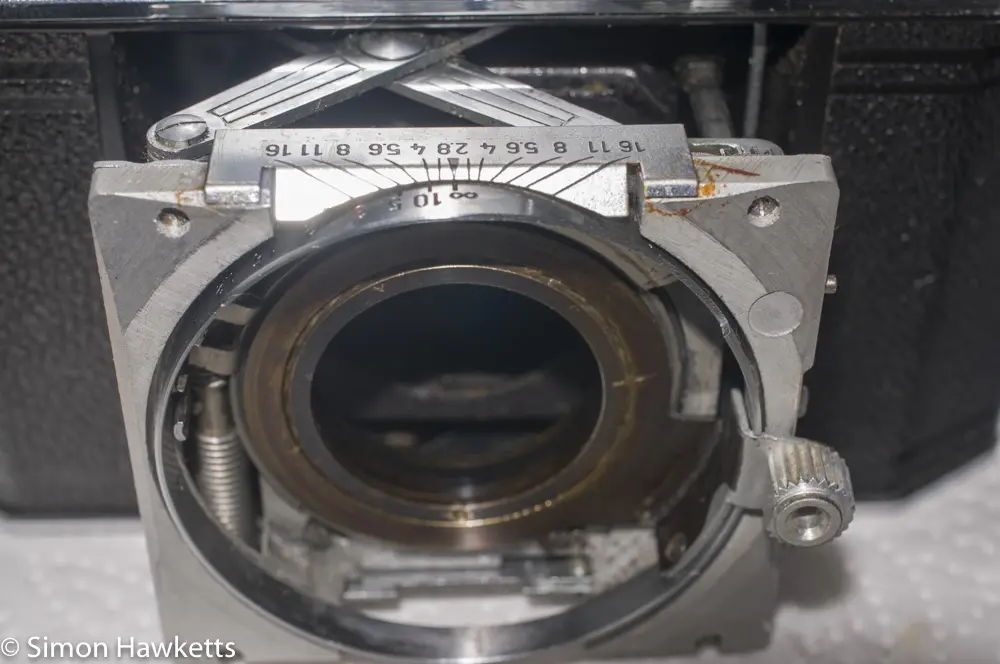
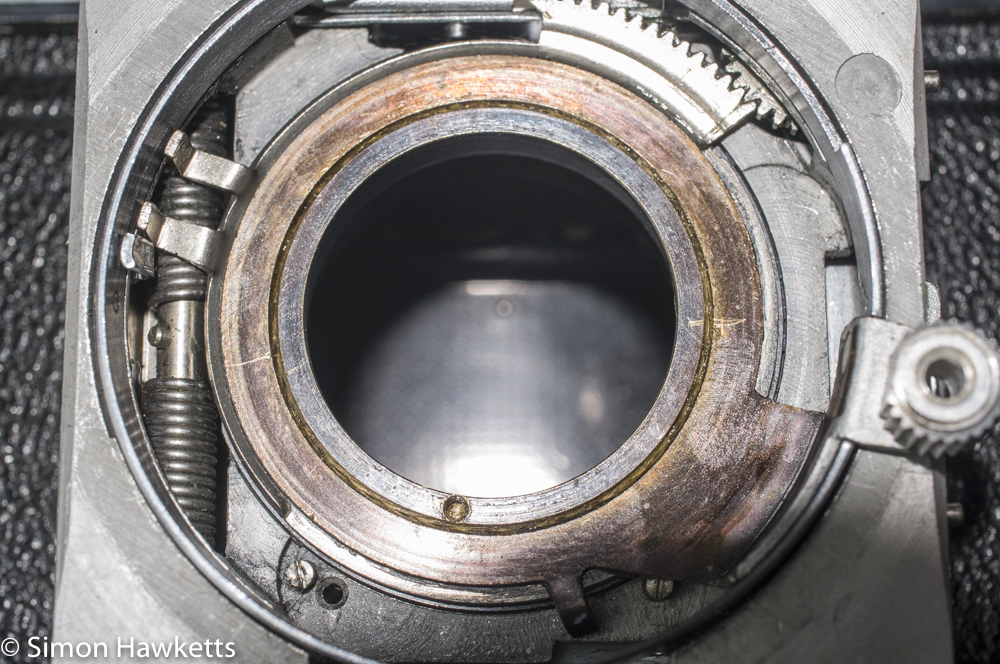
Fortunately, my model IV was not locked, although it was very stiff to operate and caused the focus scale on the top of the lens to flex as it was moved. Although it is technically possible to flush the mechanism whilst it is still connected to the camera, I don’t like doing that. I like to make sure that the old grease which is flushed out is not going to seep into the shutter and cause problems.
Removing the shutter assembly is reasonably straight forward as long as you have a tool which will get into the recessed ring which holds the shutter to the body. When you look through the back of the camera, you can see a series of rings around the lens element. The ring which needs to be undone is the thin ring which is third out from the centre.
You need a thin ring spanner to fit onto the slots, so it can be turned. Once it starts, you can move it with the blade of a thin screwdriver, but the initial unlocking is difficult without the correct tool. Be particularly careful if you try this with a screwdriver because a slip can scratch the lens or go through the bellows and cause damage which is difficult to repair.
Once the ring is removed, there is one other screw to remove, which is the one which connect the rangefinder to the shutter. On the Karat 12 this was on the bottom of the camera pointing up and so the bellows needed to be released to get to it. On the Karat IV model, it is on the top of the camera and can be removed with the bellows in place. Once the screw is removed, the shutter will pull out of the front of the camera. It’s then possible to remove the trim from the front standard by removing two screws and lifting it off two location pins on the other side.
At this point, I marked the cocking ring and the gear it mates against, so I could be sure I put them back the way they came out. Experience tells me that the cocking ring to film transport timings are crucial to getting the camera working again, so any way you can simplify it by leaving things as they are is well worth doing.
Then, the whole front standard can be removed by undoing the four screws which hold it in place.
At this point, I made two marks on the focus helicoid – the first was across the two brass rings to mark the position the helicoid was in when the lens was removed. This helps when it comes to fitting the lens back in place by making sure the lens locating pin properly fits into the helicoid. Then I turned the helicoid until it was at exactly the same level as it’s containing brass ring and marked a second line. This was to make sure that when I reassembled the two pieces I was in the correct thread and therefore the focus would be right.
With the front standard on some thick pieces of Kitchen Paper, I trickled some Ronsonol lighter fuel into the gap between the helicoid and the focus ring and started working it back and forth to free it up. Once I could move the helicoid far enough to see some threads, I used cotton buds soaked in lighter fuel to clean up as much of the old grease as I could. Basically, you just do this until the helicoid can be freed from the focus ring and can be properly cleaned. Now it may be possible to do this operation without removing the helicoid, just cleaning the threads top and bottom and then applying new grease, but I found it easier to separate the two components and clean them up.
Once the old green grease is all gone, I applied new grease to the helicoid and refitted it, using the marks I made to make sure when it was level with the focus ring the marks lined up. Oddly enough, and against all odds, I actually got it right first time!
The other thing I did whilst the front standard was off was to slightly bend the shutter release lever so that it moved the shutter release further when pressed. I then re-assembled the shutter back onto the front standard, and tried the shutter release button on the camera but found that, although it was better, the release didn’t fire 100% of the time. At this point, I wondered if there was a problem in the film advance mechanism, and since the multi-exposure interlock wasn’t always working properly, I decided to strip that down and clean it up next.
Agfa Karat IV Repairs – Film Advance Strip down
The film advance strip down is shown in pictorial form below – mostly the pictures are self-explanatory, but I’ll cover a few important points below the pictures.
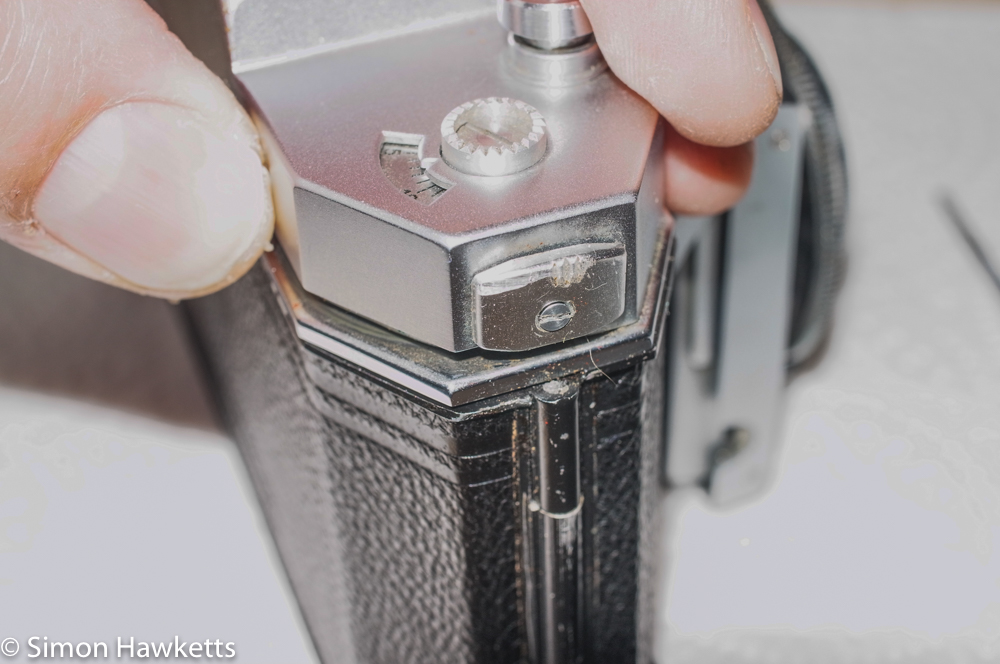
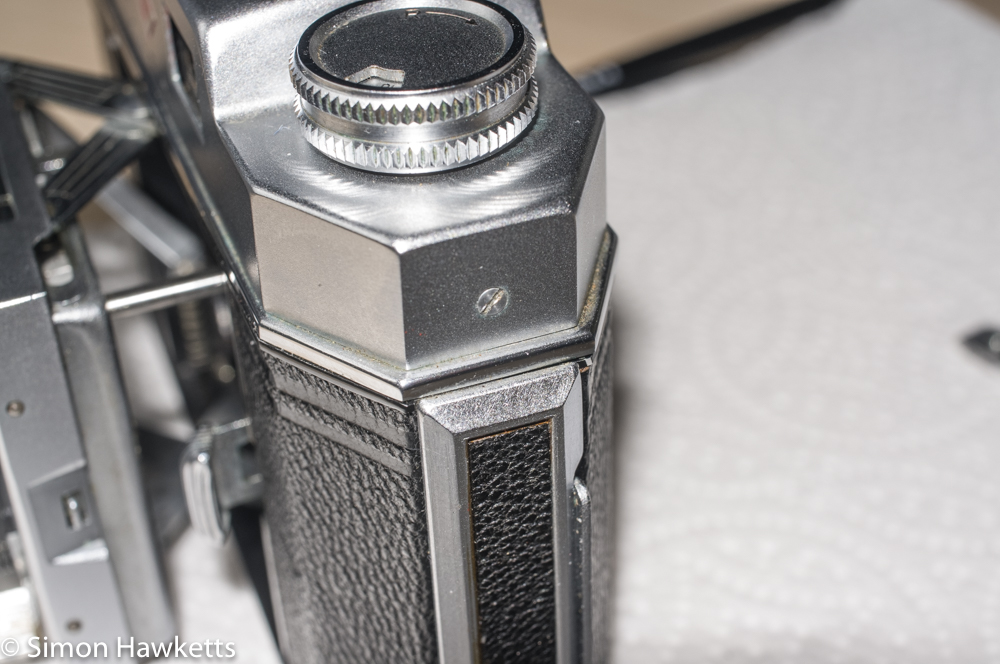

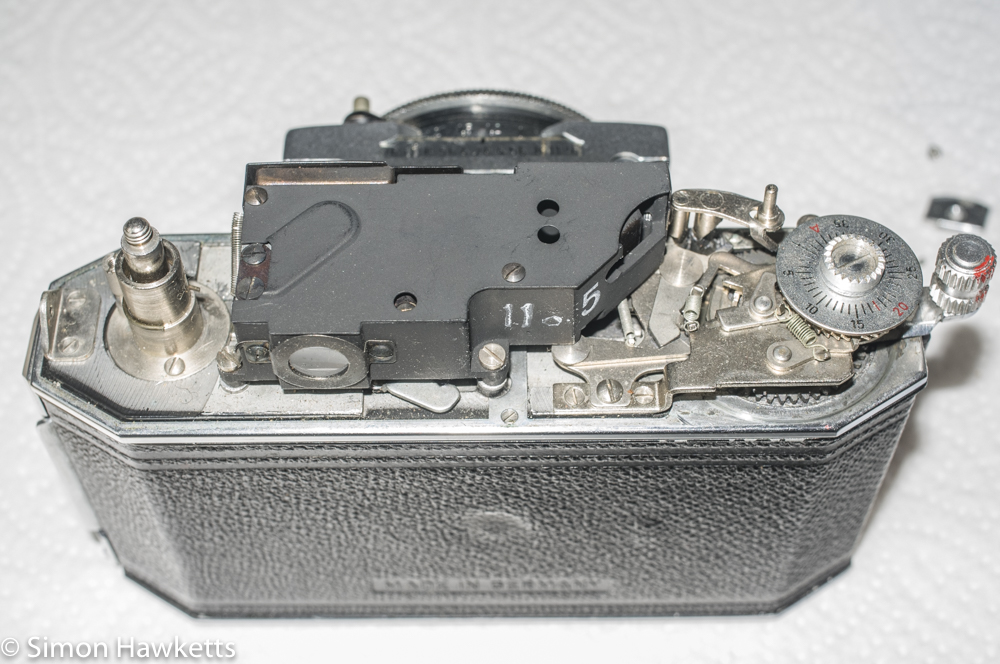
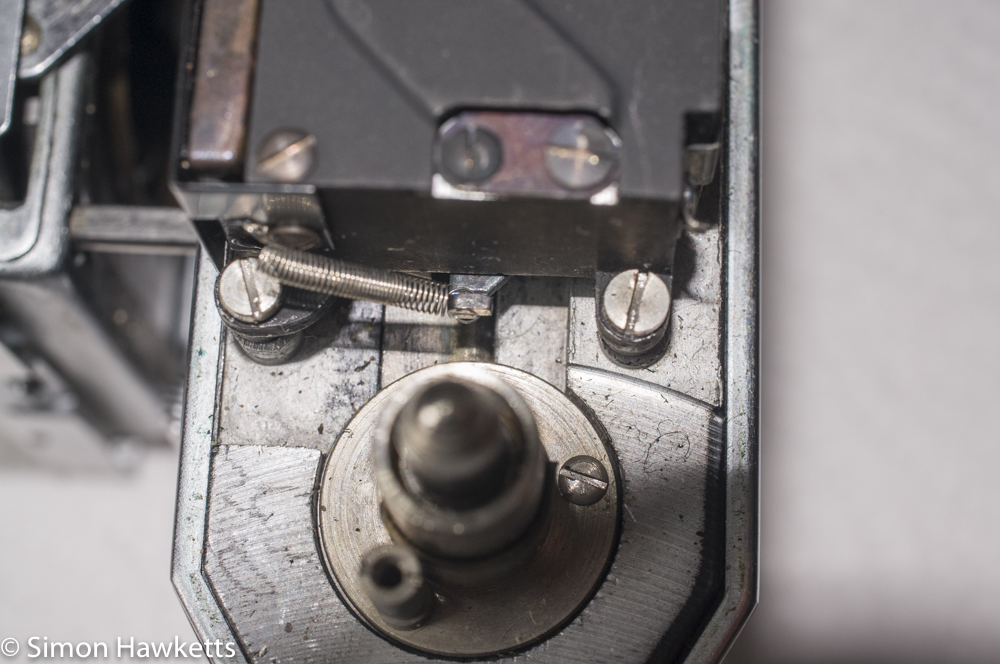
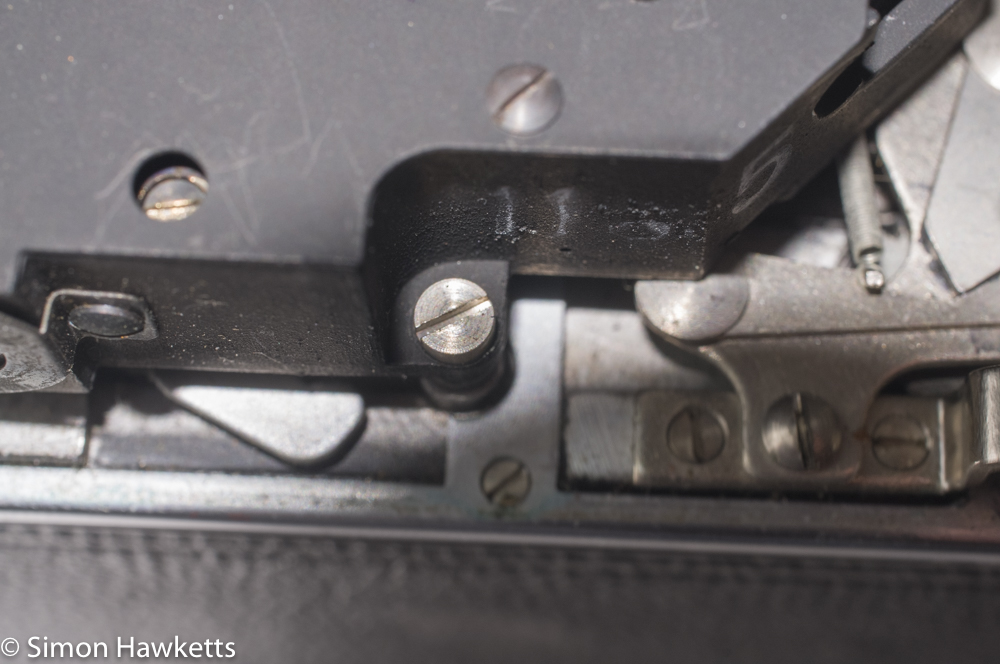

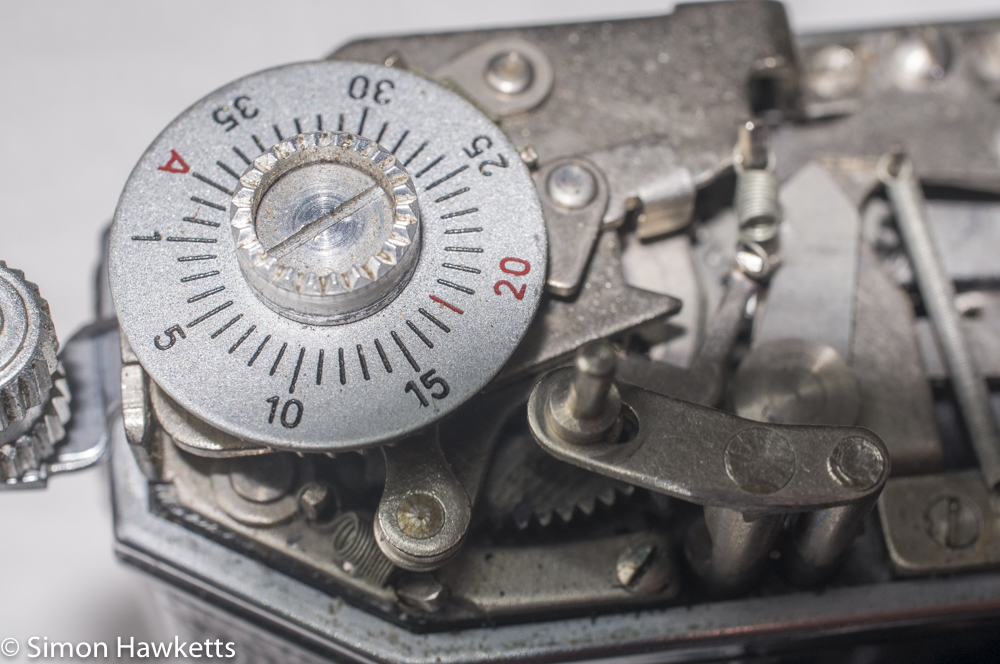
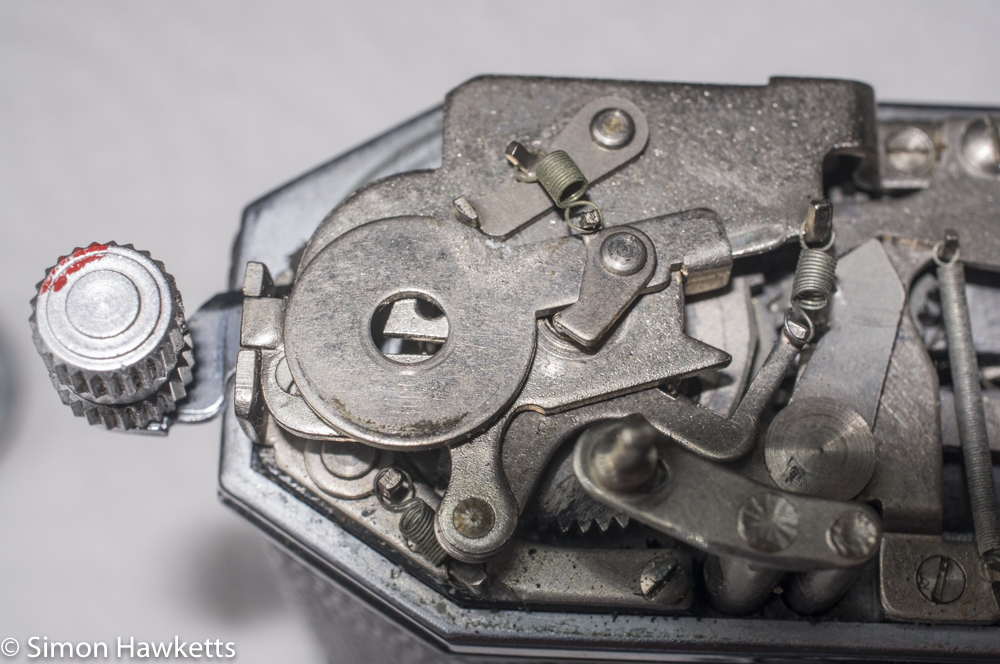
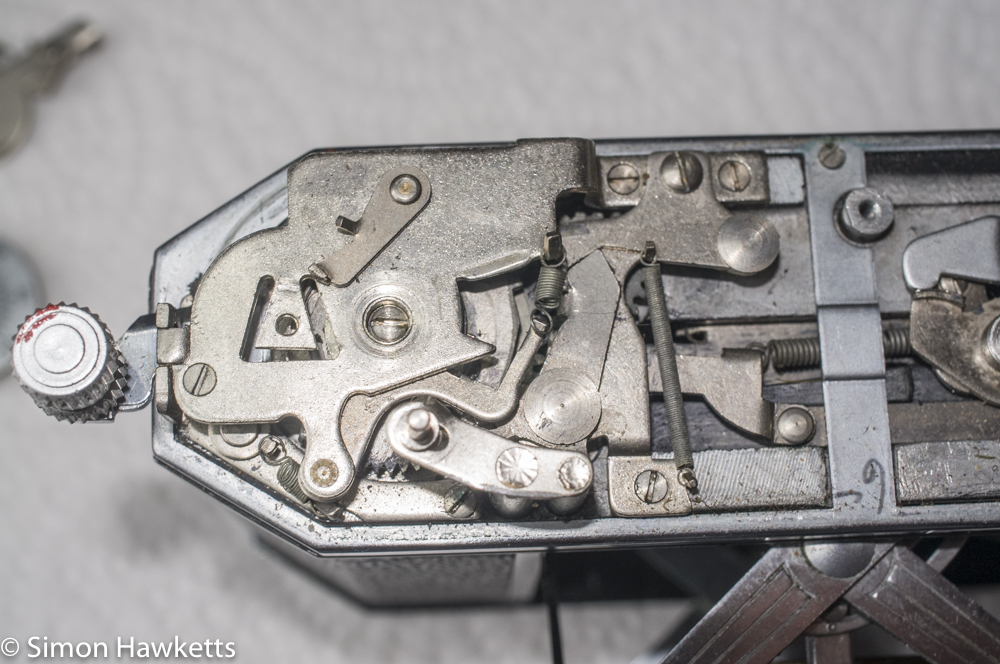
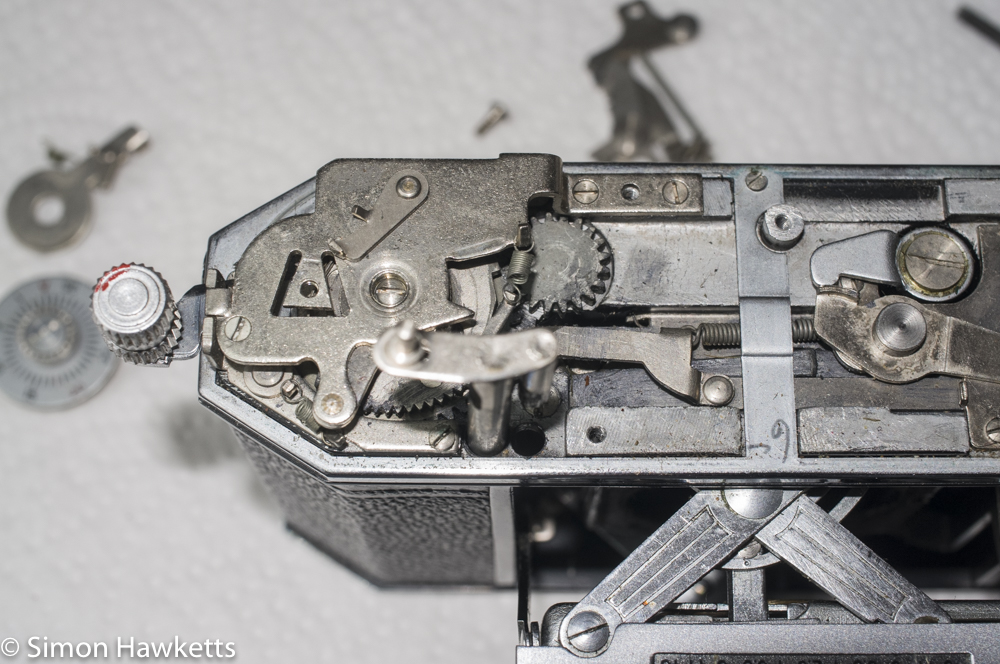
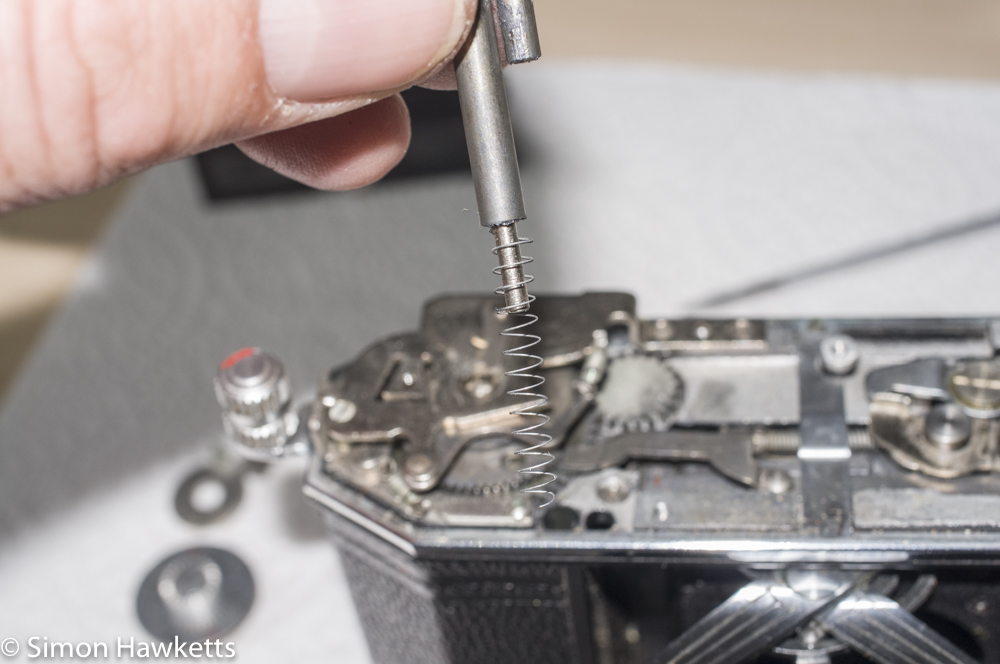

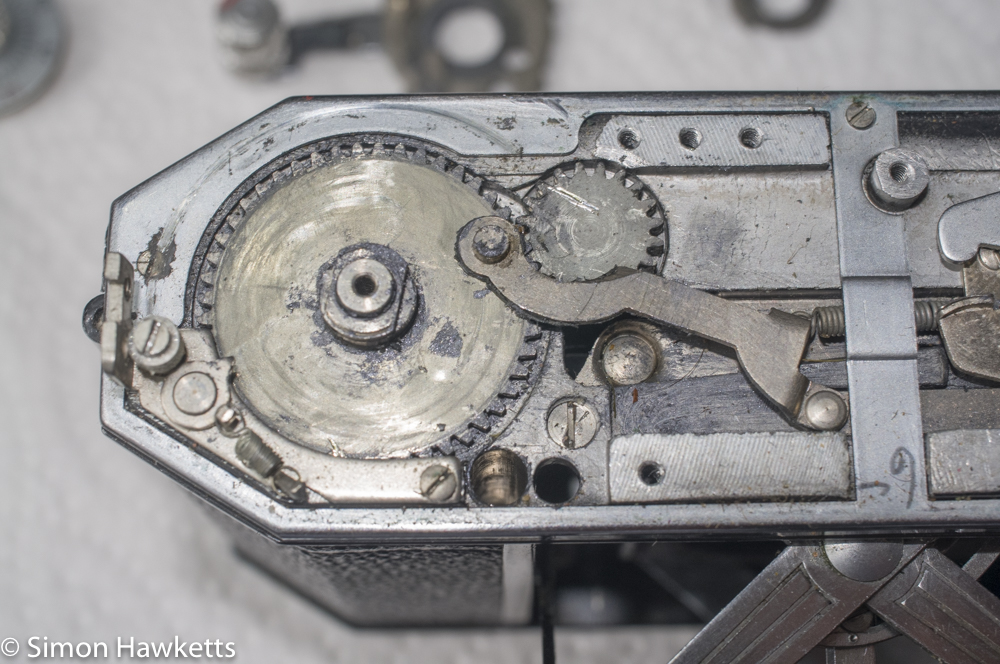
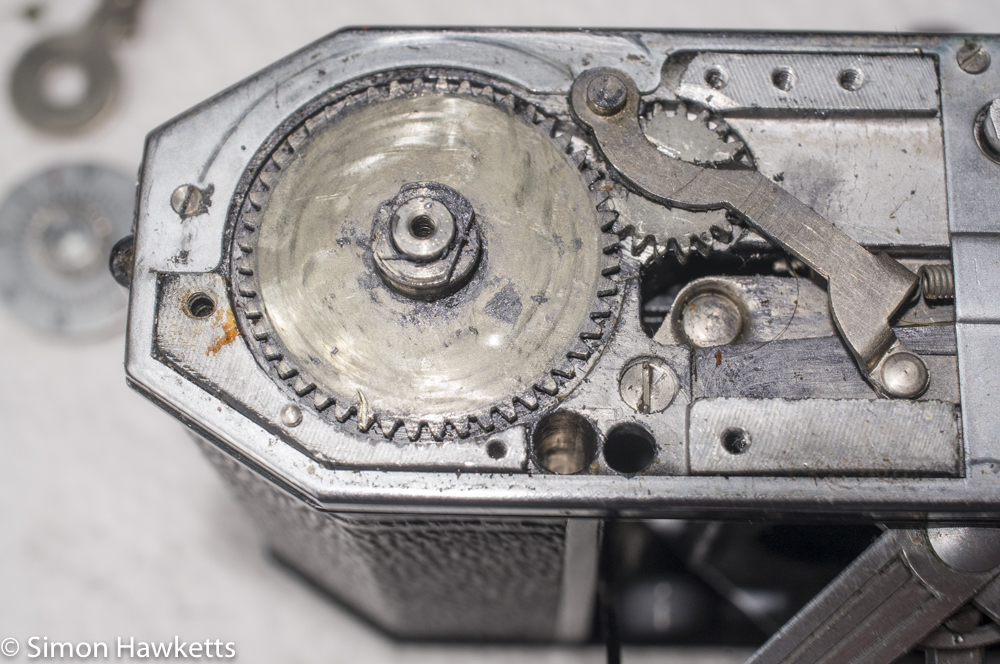
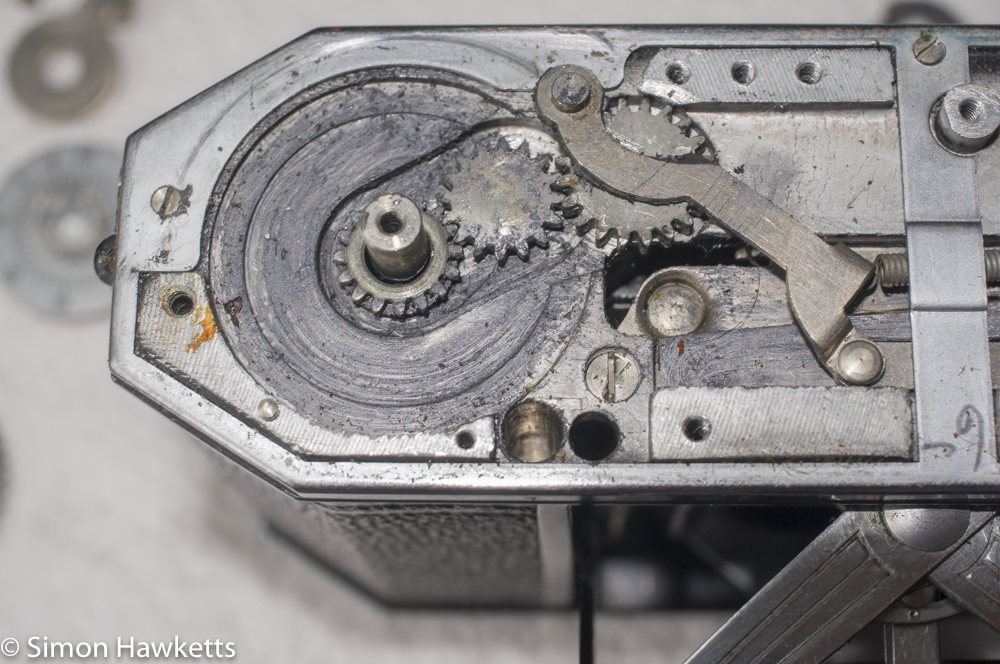
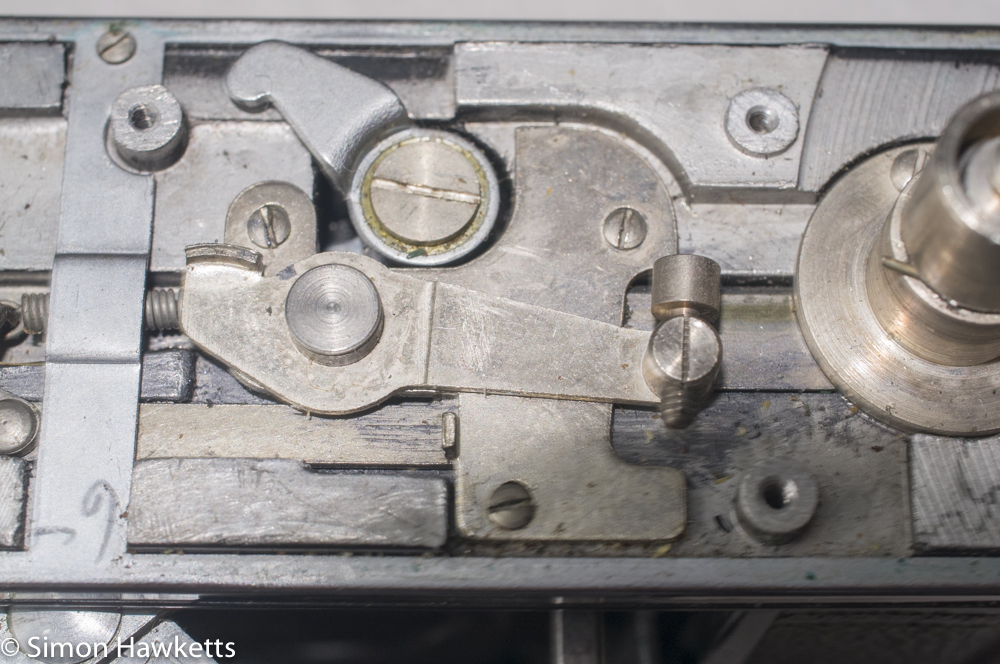
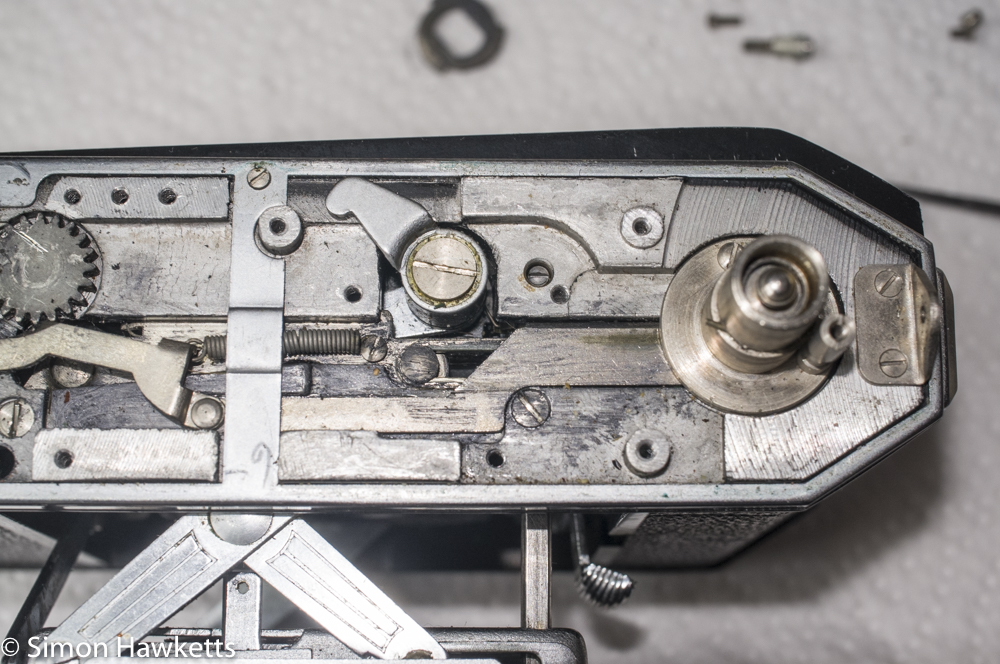
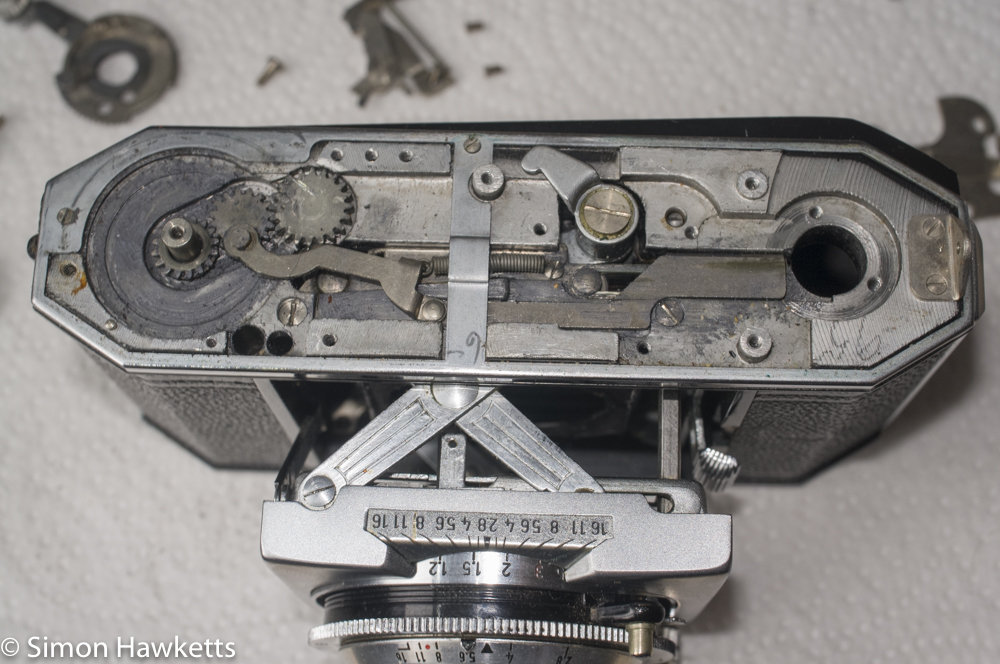
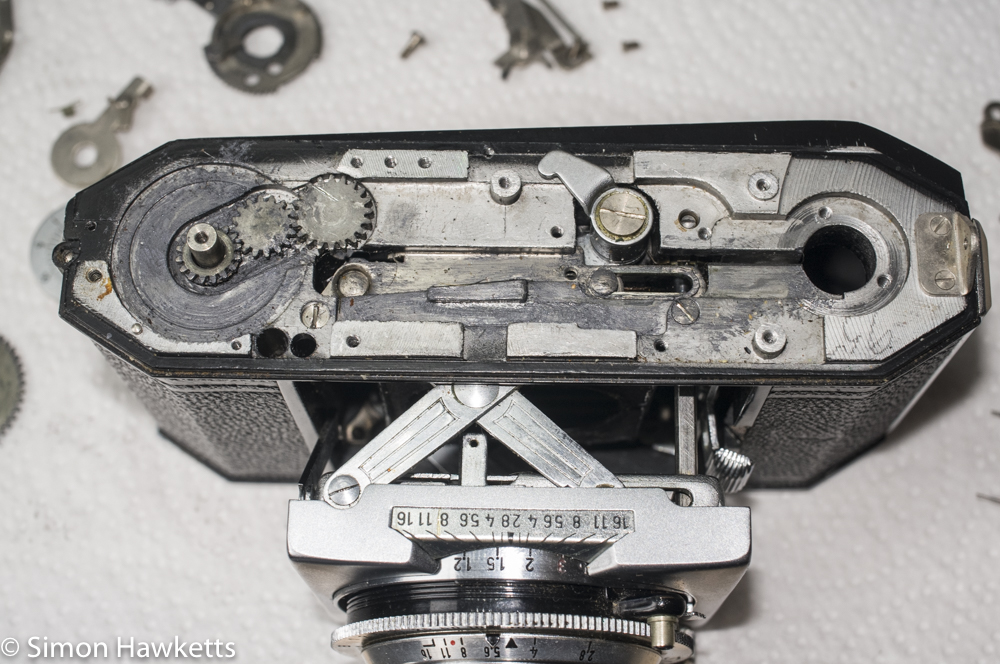
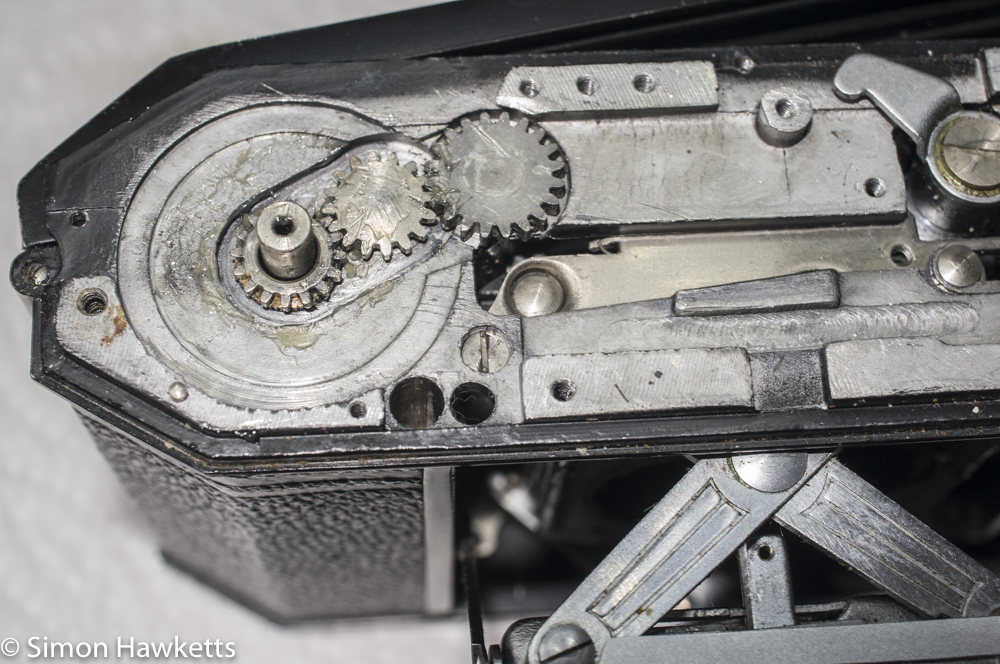
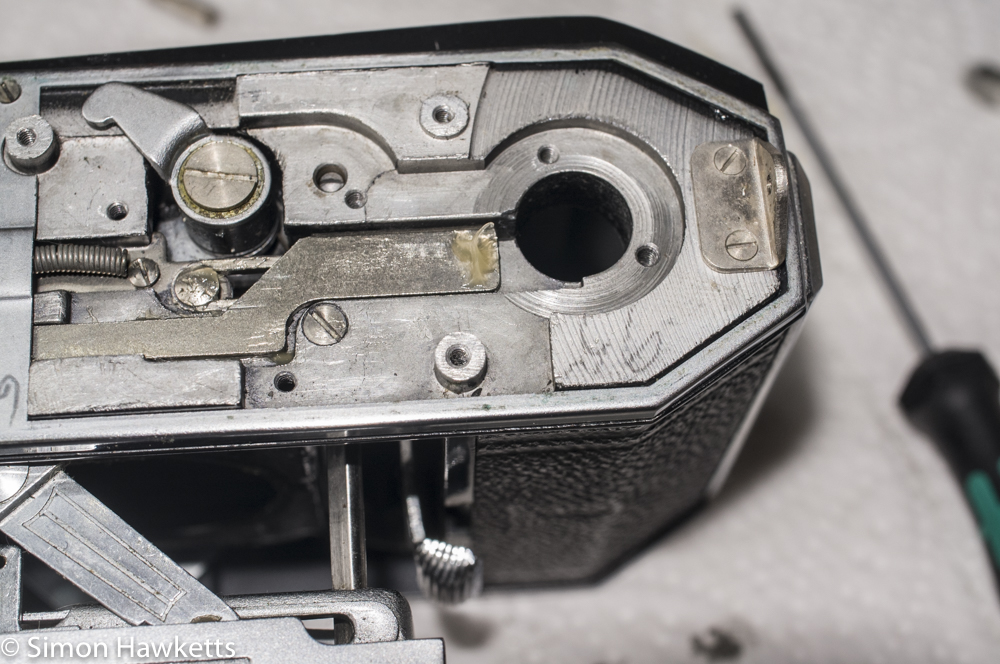
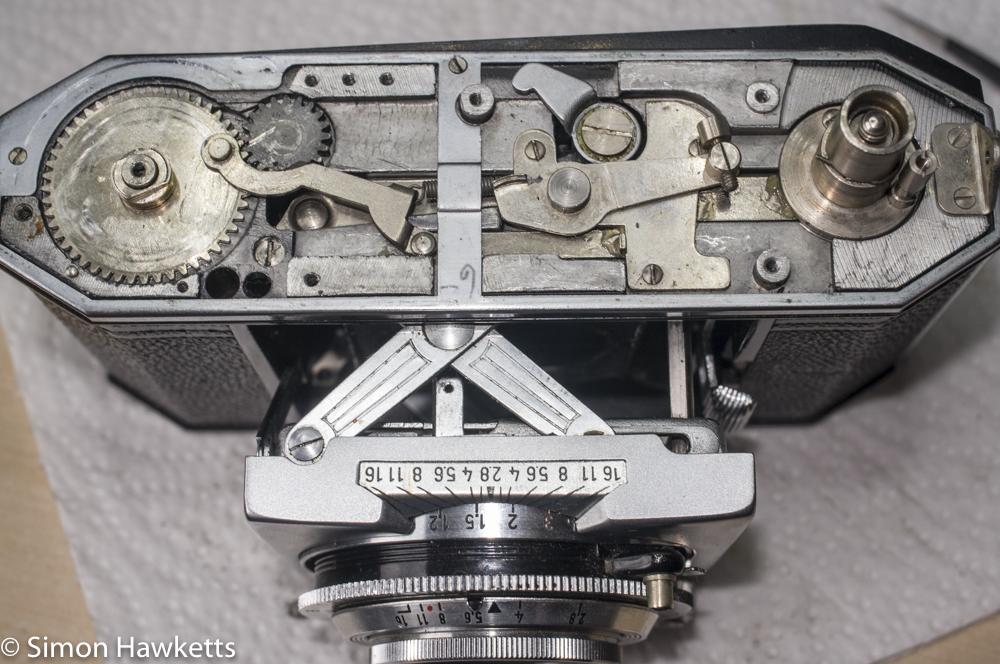
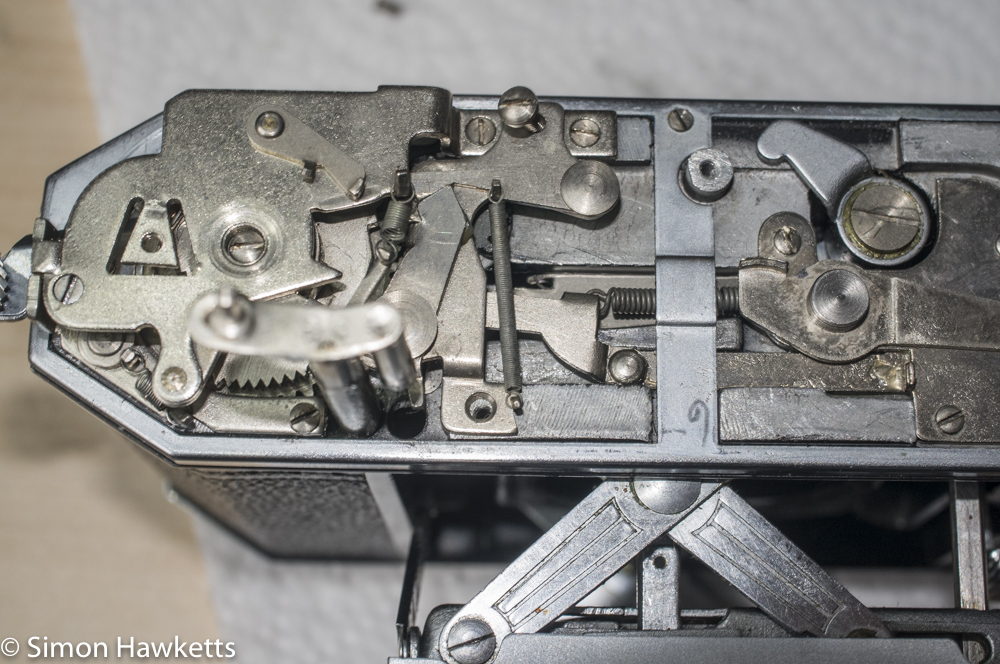
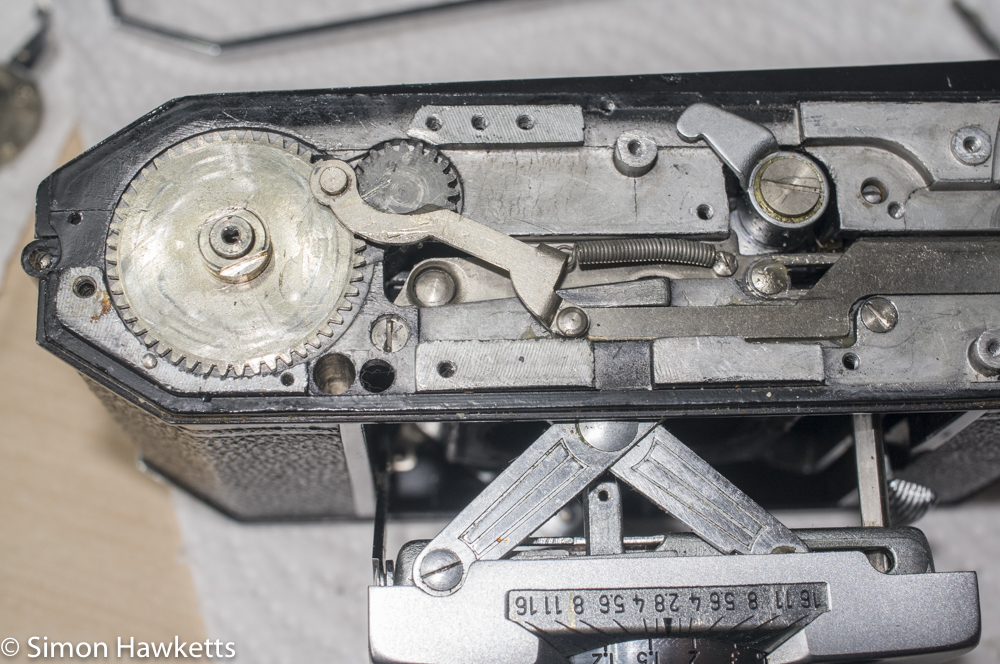
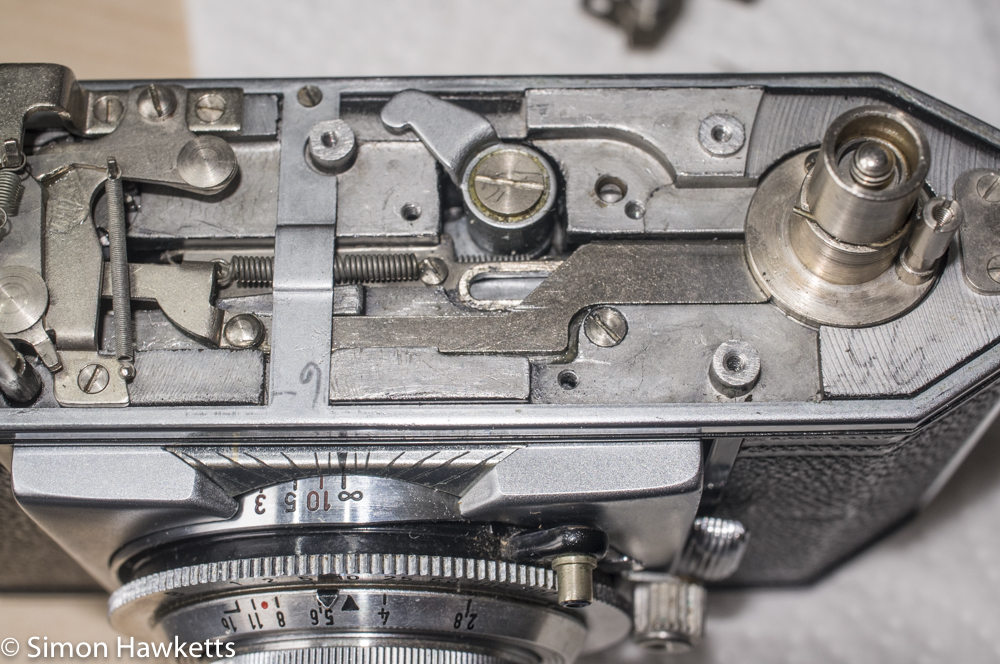
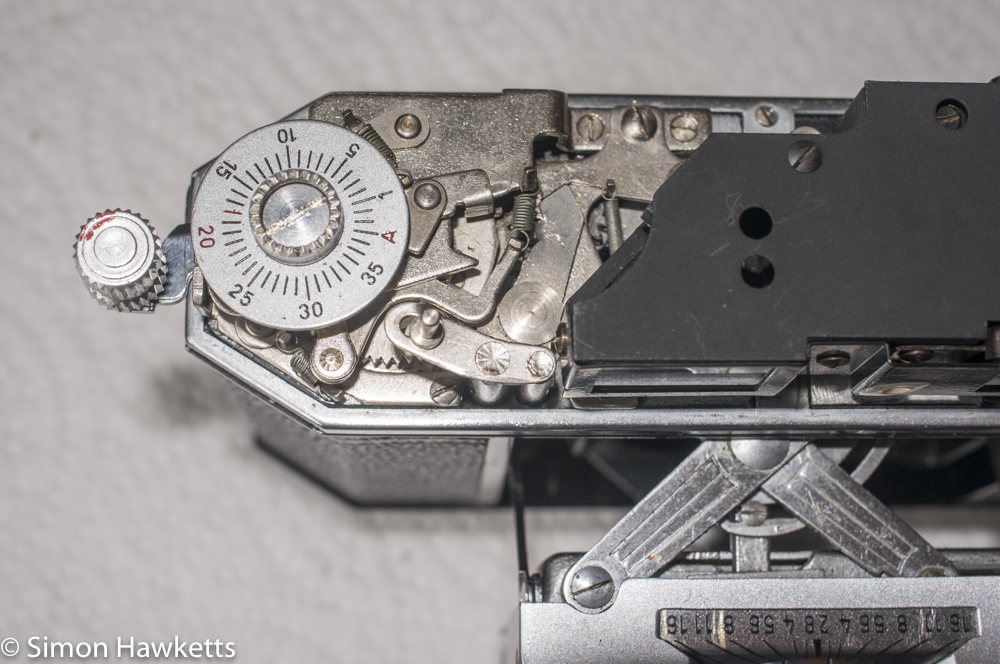
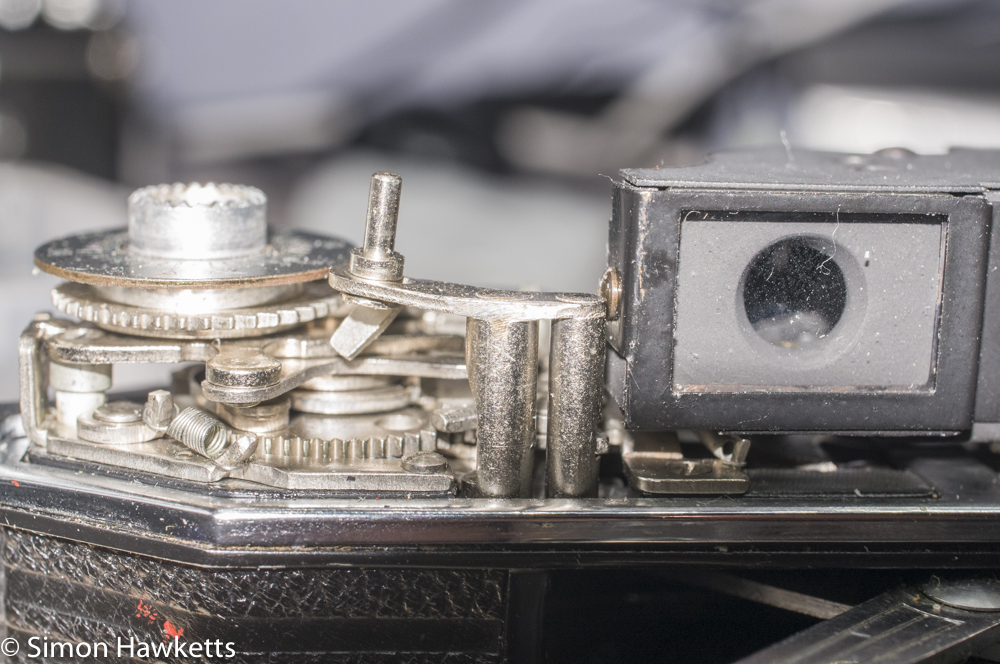
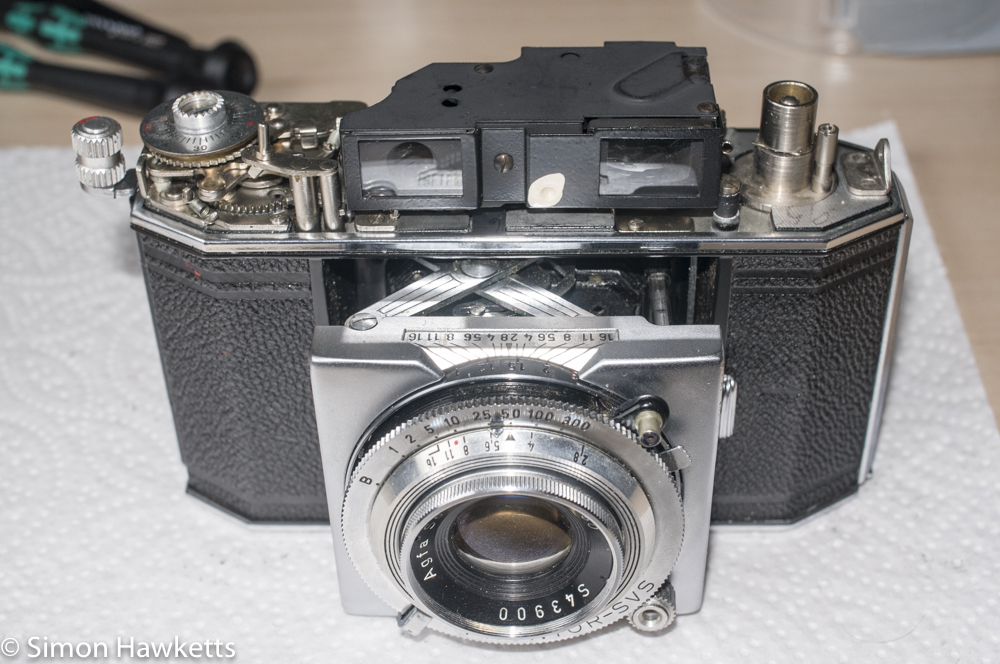
Taking the top off the Karat IV is a simple job – just remove three screws and the top of the film rewind and it pulls off. The rewind top is removed by holding the splines of the shaft with a screwdriver and turning the top. Be careful because there are several parts to the rewind top which make up the film type reminder, so it may come apart as you take it off.
To get to the film transport and frame counter, you need to remove the rangefinder, which is just a case of removing three screws and lifting it free.
Removing all the components of the film transport and frame counter was relatively simple. I cleaned the smaller components which had springs fitted with IPA and cotton buds and placed the larger components into an ultrasonic cleaner to remove all the old grease. On re-assembly, I added a small amount of grease to parts with rubbed together and just put everything back as it came off.
The points to note are:
- When re-assembling the cocking rack and winder, I needed several goes at this to get the correct placement of the cocking rack, so the shutter would cock every time and the film advance ratchet was correctly timed. This was really a question of trying a position, giving it a go, and then adjusting back or forth until everything worked. A bit laborious, but not really difficult.
- In the pictures above, you will see that I applied grease to the mechanism which sits above the cocking rack and below the rangefinder and transmits the focus movement. I did this because the cocking rack is directly below, and I assumed it would rub against the component. When I got the rangefinder assembled to the camera I found there was an odd ‘delayed action’ to the view in the viewfinder which was caused by this grease. You will see a later picture in the series where I’ve completely cleaned that component and that is how it needs to be.
- Just a general word on grease. In several of the pictures, there seems to be quite a lot of grease applied. This is just that I put an amount on, moved the mechanism to distribute the grease, and then wiped the excess off with a cotton bud. In the end, there was much less than the early pictures show.
- When the film transport and frame counter had been fully re-assembled, I cleaned the glass on the rangefinder with some white vinegar on a cotton bud which removed the dirt and grime, leaving a really nice clean display with a well-defined yellow rangefinder patch in the centre.
With all of those issues sorted, the camera was just about perfect with just one slight, but important issue. The shutter release still didn’t reliably fire the shutter 100% of the time. With the camera top off, I could make it work every time if I pressed the shutter release actuator rod at the point where the two rods join on the top, but if I pressed it at the point the shutter release button operates it didn’t always get enough downward movement to either fire the shutter or properly latch the multiple exposure prevention mechanism.
In the end, I managed to fix this by putting a slight bend in the shutter release actuator so that the pin which pushes into the release button in the top is slightly raised. In effect, I had to put two bends in it – one to change the angle and then another to straighten the pin where it sits in the release button. With this change, the camera is just about perfect and is now loaded with a roll of Kodak ColorPlus 200 film.
Discover more from Everything Vintage
Subscribe to get the latest posts sent to your email.

